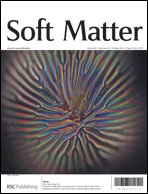The interactions between charged colloids with rod-like counterions
Abstract
We examine the force between two equally charged surfaces that is mediated by rod-like counterions of varying length and valency. The analysis is based on an extension of a previously developed approximate field theory which is accurate from the weak to the strong electrostatic coupling regimes. This theory is found to agree well with Monte Carlo simulation results for the counterion density distribution in the system. We map out the values of the plate separations and surface charge densities where the force between the plates is attractive. For sufficiently high surface charge densities and sufficiently large counterion lengths, there are two distinct regions of attraction between the surfaces: one at separations of about the counterion length that is associated with the “bridging” of the two surfaces by the counterions and another at lower separations that is due to correlations between the counterions. As the length of the rod-like counterions decreases, the “bridging” region moves to lower plate separations until the two attractive regions merge together and approach the point charge limit.


 Please wait while we load your content...
Please wait while we load your content...